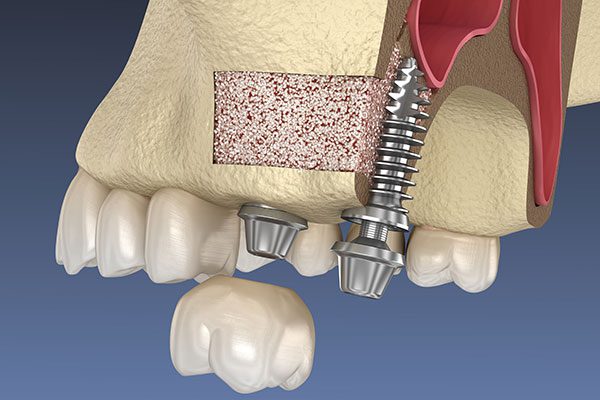Bone Graft Chicago
Bone grafting is a sophisticated dental procedure that plays a pivotal role in restoring or enhancing the structure of the jawbone. Patients who need dental implants or who have suffered dental trauma or oral disease may need bone grafting to facilitate bone growth. Cameo Dental Specialists provides bone grafting procedures at our offices in Chicago.
HOW DOES A BONE GRAFT WORK?

The success of bone grafting hinges on the phenomenon of bone remodeling. Once the graft is in place, the body’s natural processes kick in, gradually replacing the transplanted material with the patient’s own bone. This integration, known as osseointegration, fosters stability, strength, and vitality in the treated area.
WHY DO I NEED A BONE GRAFT?
Several scenarios may necessitate bone grafting.
- First of all, patients preparing to receive dental implants may need a bone graft if they have inadequate bone mass due to tooth loss or other factors. Dental implants require a solid foundation to ensure that the implant has a stable base for successful integration.
- Facial trauma or injury can result in bone loss. Bone grafts help reconstruct damaged or lost bone, restoring facial symmetry and function.
- Advanced periodontal disease can also erode the jawbone. Bone grafts aid in rebuilding the bone structure, supporting teeth, and preventing further tooth loss.
WHAT ARE THE TYPES OF BONE GRAFTS?
Several types of bone grafts cater to diverse needs:
- Autografts involve using bone material harvested from the patient’s own body, typically from the hip, tibia, or jaw. This type of graft is considered the gold standard due to its compatibility and reduced risk of rejection.
- Allografts use bone tissue from a donor, either human or animal, which is meticulously processed and sterilized. This type is a viable alternative for those unwilling or unable to undergo autografting.
- Xenografts involve using bone material from animals, typically bovine or porcine sources. The xenograft is specially treated to remove all cellular components, leaving behind a scaffold that facilitates bone regeneration.
- Alloplasts utilize synthetic materials, such as hydroxyapatite or calcium phosphate, to mimic the structure of natural bone. While lacking the biological elements of autografts, alloplasts offer a biocompatible alternative.
WHAT HAPPENS DURING BONE GRAFT SURGERY?
Bone grafting surgical procedures are conducted in several steps. The process begins with a comprehensive consultation, where one of our specialists evaluates the patient’s oral health, medical history, and the specific requirements for bone grafting.
Before the surgery, the patient receives anesthesia to ensure a pain-free experience. The type of anesthesia depends on the complexity of the graft and the patient’s comfort level. The chosen graft material is placed in the targeted area, either above or below the existing bone. The graft is secured in position, and the surgical site is closed with sutures.
Post-surgery, the body initiates the healing process. Over several months, the transplanted material integrates with the existing bone through osseointegration, promoting stability and strength. Regular follow-up appointments allow the dental professional to monitor the healing progress, address any concerns, and adjust the treatment plan as needed.
HOW LONG DOES IT TAKE A BONE GRAFT TO HEAL?
The timeline for bone graft healing can vary based on several factors, including the type of graft, the site of the procedure, and the individual’s overall health. In general, the initial healing phase, where the body forms a blood clot and initiates the healing response, takes a few days. Over the next several weeks, the transplanted bone material undergoes a process called osseointegration, gradually fusing with the existing bone.
For smaller grafts or those performed in less load-bearing areas, healing may take about three to six months. In contrast, larger grafts or those placed in areas subject to more stress may require six months to a year for complete integration and maturation.
ARE YOU PUT TO SLEEP FOR DENTAL BONE GRAFTING?
The anesthesia approach for dental bone graft procedures depends on the complexity of the surgery and the patient’s comfort level. In many cases, patients are given local anesthesia, which numbs the specific area where the graft is placed. This allows the patient to remain awake and aware during the procedure while ensuring they don’t experience pain.
For more extensive grafts or for individuals who may experience anxiety about the procedure, we offer sedation options ranging from oral sedatives to intravenous (IV) sedation. In some cases, we administer general anesthesia, putting the patient into a deep sleep for the duration of the surgery.
HOW TO SPEED UP BONE GRAFT HEALING
It is crucial to follow the post-operative care instructions we provide. This may include prescribed medications, proper oral hygiene practices, and avoiding activities that could disrupt the graft site.
A well-balanced diet rich in vitamins and minerals is essential for optimal healing. Nutrients like calcium, vitamin D, and phosphorus contribute to bone health. Additionally, avoiding tobacco and limiting alcohol intake supports overall healing.
During the initial healing phase, it’s vital to avoid activities that could put excessive pressure on the graft site. Also remember to stay hydrated and come in for regular follow-up appointments.
WHEN CAN I EAT SOLID FOOD AFTER A BONE GRAFT?
During the initial days after the procedure, a soft and liquid diet is usually advised to minimize stress on the graft site. This may include items like soups, yogurt, smoothies, and mashed potatoes.
As the healing progresses you can resume eating solid foods. It’s essential to avoid hard or crunchy foods during the initial healing phase to prevent disruption to the graft site.
BONE GRAFT PROCEDURES ARE AVAILABLE AT CAMEO DENTAL SPECIALISTS IN CHICAGO
Call us at (630) 332-8717 today for more information. If you’re looking for an oral surgeon in Chicago, we have offices in River Forest, La Grange, West Loop, Berwyn, and Elmhurst.